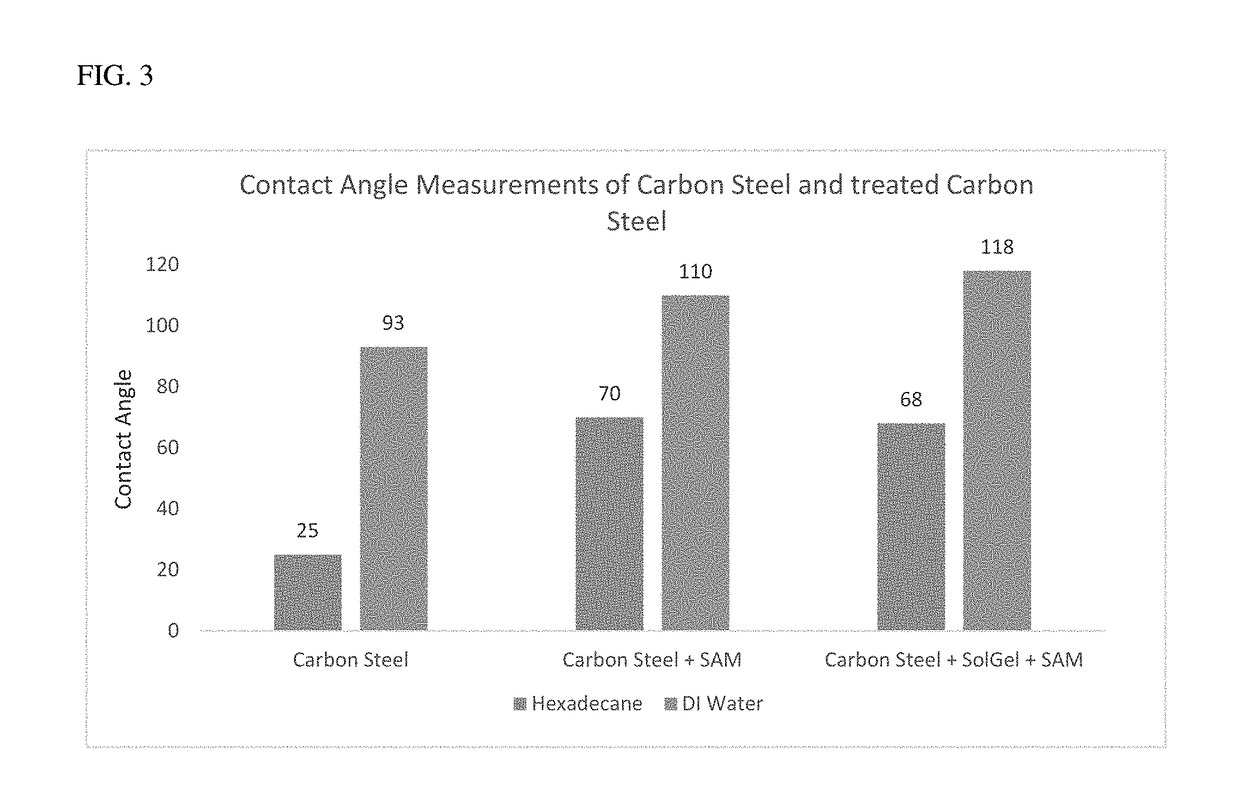Methods of applying hybrid sol-gel sam layers to equipment and products and apparatus comprising such hybrid layers
a technology of sol-gel and hybrid layer, applied in the direction of drilling composition, chemical apparatus and processes, etc., can solve the problems of insufficient adhesion of sam to the substrate, problems such as problems, and the sam may not be adequately anchored to the substrate, and achieve less stable and higher material loss.
- Summary
- Abstract
- Description
- Claims
- Application Information
AI Technical Summary
Benefits of technology
Problems solved by technology
Method used
Image
Examples
examples
[0124]The following non-limiting examples are being provided merely to illustrate certain, but not all embodiments and features of the present invention. These examples are not intended to, are not to be taken to, and certainly do not limit the scope of the claims of the present invention.
example no.1
Example No. 1
Sample Preparation—Application of Coating
Substrate: Carbon Steel. Dimension: 2.9″ L / 1″ W / 0.12″ T
[0125]The carbon steel utilized is a type of Iron steel with less than 2% of Carbon content and small composition of manganese, phosphorus, sulfur and silicon. This type of carbon steel is the most widely used Steel in Oil and Gas Industry, commonly used in flow lines, structural components, pipelines etc.
[0126]The following procedure was utilized to prepare both a Sol-Gel / SAM coated sample (using the full procedure), as well as a SAM only coated sample (using only the 2nd half of the procedure).
[0127]A carbon steel substrate is first cleaned with a cleaner such that there is no debris, oil residue, dust or dirt. For the purpose of this example, a commercially heavy duty degreaser was used to clean the carbon steel substrate. Next, the carbon steel substrate was cleaned using a sponge, rinsed with tap water to remove all the soap residue. Next, the carbon steel substrate was ...
example no.2
Example No. 2
Application Method
Substrate: 316L Stainless Steel-Dimension: 2″ L / 2″ W / 0.01″ T
[0155]The 316 Stainless Steel is a standard molybdenum-bearing grade of austenitic stainless steels. 316L is the low carbon version of 316. It is used in heavy gauge welded components. It is rough, offers higher creep, stress to rupture and tensile strength.
[0156]The 316L stainless steel substrate is first cleaned with a cleaner such that there is no debris, oil residue, dust or dirt. For the purpose of this example, a commercially available heavy duty degreaser was used to clean the stainless steel (SS) substrate. The SS substrate was cleaned using a sponge, rinsed with tap water to remove all the soap residue. The SS substrate was wiped dry using a clean lint free cloth (optionally an alcohol such as Isopropyl alcohol can be used as a final rinse and then dry the substrate with a clean lint free cloth).
[0157]Approximately 1 ml of the sol-gel solution is taken on a clean and dry lint free clo...
PUM
| Property | Measurement | Unit |
|---|---|---|
| length | aaaaa | aaaaa |
| length | aaaaa | aaaaa |
| length | aaaaa | aaaaa |
Abstract
Description
Claims
Application Information
 Login to View More
Login to View More - R&D
- Intellectual Property
- Life Sciences
- Materials
- Tech Scout
- Unparalleled Data Quality
- Higher Quality Content
- 60% Fewer Hallucinations
Browse by: Latest US Patents, China's latest patents, Technical Efficacy Thesaurus, Application Domain, Technology Topic, Popular Technical Reports.
© 2025 PatSnap. All rights reserved.Legal|Privacy policy|Modern Slavery Act Transparency Statement|Sitemap|About US| Contact US: help@patsnap.com



